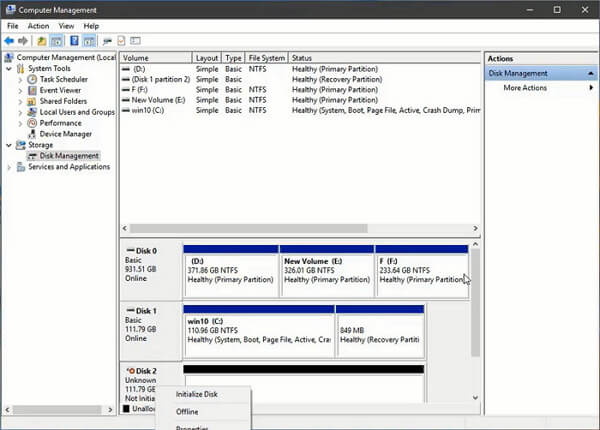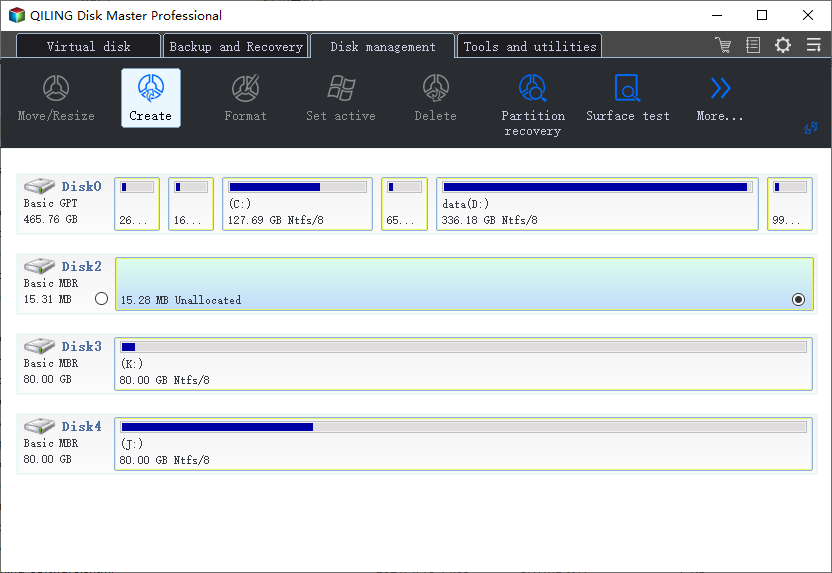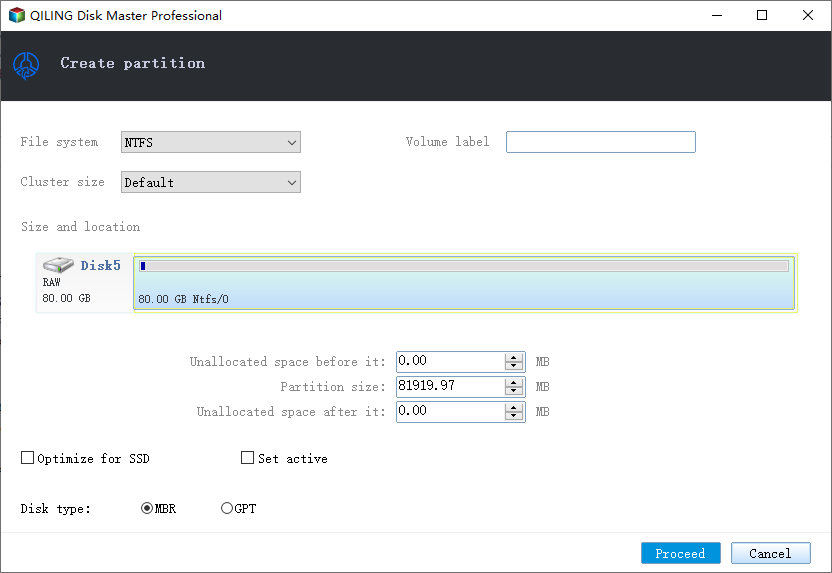How to Initialize SSD in Windows 10/8/7, How to Initialize a Hard Drive

To initialize a new SSD in Windows 10 using Disk Management, first, open the Disk Management tool by searching for it in the Start menu or typing "diskmgmt.msc" in the Run dialog box (Windows key + R).
Move your mouse to the lower-To set up a new SSD, right-click on the Start icon, select "Disk Management", and initialize it by choosing MBR or GPT. Then, create a new volume by right-clicking on the unallocated area and following the on-screen wizard, selecting a drive letter and clicking "Next" to format the partition.
How to Initialize SSD Windows 10/8/7 in 3 Ways
You can initialize a hard drive or SSD in Windows 10/8/7 using a third-party free partition tool, Disk Management, or Diskpart commands. To do so, you can use a free partition tool, which provides a user-friendly interface to initialize the drive.
Method 1. Using Qiling Partition Master - a Free Disk Management Tool
For computer novices, the best way to manage your disk is by using an easy-to-use disk management software, which can help you avoid any harm to your computer due to misoperations, such as wrong command lines in Command Prompt.
Qiling Partition Master Free allows you to initialize an SSD or HDD with a click, and offers one-stop partition and disk management solutions for your Windows computer, including partition management, disk management, and other features.
- The Pro version of the software allows for resizing and moving partitions to optimize disk usage, and can directly transfer free space from other drives to the target drive without deleting or formatting, making it ideal for scenarios like moving free space from the D drive to the C drive.
- Create, format, delete, and recovery partitions without data loss
- You can use the `dd` command to clone an entire disk to another, even if the target partition is smaller than the source. The syntax is `dd if=/dev/sdx of=/dev/sdy bs=16M`, where `/dev/sdx` is the source disk and `/dev/sdy` is the target disk.
- To perform these conversions, you can use the built-in disk management tools in Windows, specifically the Diskpart utility. This utility allows you to convert a logical partition to a primary partition, convert a primary partition to a logical partition, convert a FAT32 partition to an NTFS partition, convert a MBR disk to a GPT disk, or convert a GPT disk to a MBR disk.
- Completely wipe out all the data on the hard disk to prevent information from being leaked or recovered. This can be done by using a software tool that overwrites all data on the hard disk, making it impossible to recover any information.
To initialize an SSD in Windows 10, 8, and 7, download a free partition manager and follow the steps to convert the drive to GPT or MBR, depending on your needs.
Step 1. Open Qiling Partition Master. Connect the hard drive or SSD to PC.
In the Disk Management utility, select the target HDD or SSD and click "Create" to initiate the process of creating a new partition or volume.

Step 2. Select disk type "MBR" or "GPT", and click "Proceed" to create a partition.

After initialization, all disk space remains unallocated and unusable for program installation or file storage. To utilize the MBR or GPT disk, you can continue using Qiling free partition software to create partitions and set the file system.
Method 2. Using Disk Management to Initialize SSD
Step 1. To access Disk Management in Windows, press the "Windows + R" key, type "diskmgmt.msc" and click OK, or in Windows 7, right-click Computer and select Manage.
Step 2. Right-click the hard drive or SSD you want to initialize, and then click "Initialize Disk", or first make it online if it's listed as Offline.

Step 3. To initialize a disk, open the Initialize Disk dialog box and select the correct disk to initialize. You can then click OK to accept the default partition style, or choose to change the partition style to either GPT or MBR. This allows you to set up the disk for use with your operating system.
Method 3. Using Diskpart Commands to Initialize Hard Drive
Step 1. Open the Start Menu, type diskpart, press Enter.
Step 2. Type these commands if you want to initialize the disk to MBR/GPT, and press Enter after each command.
list disk > select disk # > convert MBR/GPT
Step 3. 1. `fdisk /dev/sdb` (replace `sdb` with your actual disk device name) 2.
list disk > select disk # > clean > create partition primary > format quick fs=ntfs > assign > exit
Step 4. If you need to create the primary partition on the GPT disk, please use the commands below.
list disk > select disk # > clean > convert gpt > create partition primary > format quick fs=ntfs > assign > exit
MBR VS GPT | Initialize SSD as MBR or GPT
MBR (Master Boot Record) and GPT (GUID Partition Table) are two partition styles used on Windows-based computers. GPT has several advantages over MBR, including improved stability and support for 4K alignment, which is beneficial for solid-state drives (SSDs).
The Master Boot Record (MBR) has limitations, supporting only up to 2 TB partition size and allowing for only four primary partitions. In contrast, a GPT (GUID Partition Table) disk can support larger volumes and create unlimited partitions, making it a more flexible option. While Windows 7 can only be partitioned with MBR, Windows 8 and 10 are recommended to use GPT for partitioning.
The choice of partition style depends on whether a computer is BIOS booted or UEFI booted, with BIOS+MBR and UEFI+GPT being the commonly used modes.
If you're interested in learning more about Master Boot Records (MBR) and GUID Partition Table (GPT), you can click on the link provided to read the full guides.
How to Convert MBR to GPT or GPT to MBR Without Data Loss
The choice between initializing a hard drive to MBR or GPT depends on the disk size, system boot mode, and desired number of partitions.
Sometimes you need to convert disk styles, such as when installing Windows and encountering errors like "Windows cannot be installed to this disk. The selected disk has an MBR partition table" or "Windows Cannot be Installed to This Disk. The Selected Disk is of the GPT Partition Style". Converting the initialized SSD from MBR to GPT or from GPT to MBR can resolve these issues.
To convert MBR to GPT or vice versa using Qiling Partition Master, follow these steps: ...
Read More: When Do You Need to Initialize SSD/HDD
1. Got a brand new hard drive or SSD, but it is not showing up in File Explorer.
If you plug a new blank hard disk drive (HDD) or solid-state disk (SSD) into your PC running Windows 10/8/7 but don't see it in File Explorer, you may need to add a drive letter or initialize it before using it.
2. Get error "Disk Unknown Not Initialized".
When trying to access a hard drive or SSD, you may encounter the error "Disk 1 is unknown, not initialized, unallocated" in Windows 10/8/7. In this scenario, you'll need to initialize the disk for proper use.
3. Get error "You must initialize a disk before Logical Disk Manager can access it".
When you connect an external hard drive (HDD) or solid-state drive (SSD) to your computer, but it doesn't appear in My Computer or This PC, you may encounter an error message when trying to access it through Disk Management. To resolve this issue, you need to initialize the disk and format it with a file system, allowing you to start using it.
Warning
Initializing a disk with existing data will result in data loss. To avoid this, you can use Qiling Backup Free to quickly back up the HDD/SSD and recover the backup to a secure location.
Summary on How to Initialize a Hard Drive
You can initialize a hard drive in three ways: using Qiling Partition Master, Disk Management, or Command Prompt. For ease of use and security, we highly recommend using Qiling Partition Master, which is suitable for both beginners and experts to manage disks or drives easily.
FAQs on How to Initialize SSD Windows 10
If you're experiencing issues with initializing a hard drive, you're not alone. The top four highly relevant questions on this topic are: how to initialize a hard drive, what happens when a hard drive won't initialize, how to fix a hard drive that won't initialize, and how to recover data from a hard drive that won't initialize. If you're struggling with any of these problems, you can find helpful methods and solutions here.
How do I initialize an SSD in Windows 10?
Initializing an SSD can be done easily using Qiling Partition Master Free, which is a simple and effective way to get your SSD up and running.
Step 1. Connect your SD to PC. Run Qiling Partition Master.
Step 2. Right-click the SSD and select "Initialize to MBR" or "Initialize to GPT" as you want.
Step 3. Execute the operation and wait for the process to complete.
Do I need to initialize SSD before cloning?
It is unnecessary to initialize SSD if you are performing a clean installation of your operating system, or cloning HDD to SSD, both of which will initialize and format the new SSD during the process.
Should I initialize my SSD as MBR or GPT?
MBR and GPT have different interfaces, with MBR only supporting up to 2 TB partition sizes and creating only four primary partitions, whereas GPT can support larger volumes and theoretically unlimited partitions. Additionally, GPT disks offer improved performance and security.
You can convert a Master Boot Record (MBR) to a GUID Partition Table (GPT) using Qiling Partition Master without needing to format the disk.
Why won't my SSD show up?
If your SSD is not showing up in Windows File Explorer or Disk Management, there are several potential causes. These include issues with the SSD itself, such as a faulty drive or incorrect configuration, as well as problems with the operating system, like corrupted system files or incorrect disk drivers. Additionally, hardware conflicts, such as a malfunctioning SATA port or a faulty motherboard, can also prevent the SSD from being recognized.
- The drive letter of SSD is missing or conflicting.
- SSD is not initialized.
- The file system of SSD is not supported.
- There are disk driver issues.
The SSD not showing up issue can be resolved by reassigning the drive letter, initializing the SSD, changing the file system, or upgrading or reinstalling the SSD drive, addressing the problem from four different angles.
How do I get my computer to recognize a new SSD?
If your SSD is not showing up in Windows 10, you can try to get your computer to recognize the new SSD by booting from a live USB, entering the BIOS settings, and selecting the SSD as the boot device. Alternatively, you can try to initialize the SSD in Disk Management, or use a third-party tool like CrystalDiskInfo to check for any issues with the SSD.
- Assign a new drive letter for the SSD
- Initialize SSD on Windows 10
- Format the SSD with a proper file system
- Update SSD divers
Related Articles
- Best Disk Cloning Software for Windows 7
- Download System Clone Software to Clone OS in 2 Procedures
- How to Merge C and D Drive in Windows 11/10 Without Losing Data - Qiling
- How to Secure Erase SSD or HDD for Free
- SFC SCANNOW Finds Corrupted Files But Unable to Fix [Solved]
- Fix 'System C Drive Full' Error in Windows Server 2019/2016/2012